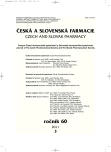Synthesis and basic physicochemical properties of 1-[3-(Y-alkoxyphenylcarbamoyloxy)-2--hydroxypropyl]-4-(2-methylphenyl)piperazinium chlorides
Authors:
Ivan Malík 1; Eva Sedlárová 1; Fils Andriamainty 1; Jana Gališinová 1; Jozef Csöllei 2; Ján Vančo 2
Authors‘ workplace:
Univerzita Komenského Bratislava, Farmaceutická fakulta, Katedra farmaceutickej chémie
1; Veterinární a farmaceutická univerzita Brno, Farmaceutická fakulta, Ústav chemických léčiv
2
Published in:
Čes. slov. Farm., 2011; 60, 137-143
Category:
Original Articles
Overview
1-[3-(Y-Alkoxyphenylcarbamoyloxy)-2-hydroxypropyl]-4-(2-methylphenyl)piperazinium chlorides (labelled as 7a–7d) were prepared within a complex study of the relationships between the chemical structure, physicochemical properties and biological (antiarrhythmic, antihypertensive) activity of dual acting compounds. Chemical structures of basic forms (labelled as 7a2C–7d2C) and appropriate monochlorides (labelled as 7a–7d) were confirmed by 1H-NMR, 13C-NMR, MS and IR spectral and elemental analysis. The estimated physicochemical parameters included the melting point data, solubility profile in various media, purity checking (adsorption thin-layer chromatography), surface activity determination (Traube stalagmometric method), acidobasic characteristics (pKa value determination by alkalimetric titration) as well as the log ε values estimation by UV/VIS spectrophotometry. Other experimental values under consideration were lipohydrophilic characteristics using reversed-phase thin-layer chromatography (RM readouts) RP-HPLC (log k’ data) and the log Pexps estimated in octan-1-ol/phosphate buffer medium.
Key words:
dual acting α- and ß-blockers – N-phenylpiperazine – spectral characteristics – acidobasic properties – lipophilicity
Sources
1. Louis, W. J., McNeil, J. J., Drummer, O. H.: The pharmacology of combined alpha – beta-blockade I. Drugs 1984; 28, 16–34.
2. Cope, D. H. P., Crawford, M. C.: Labetalol in controlled hypotension. Administration of labetalol when adequate hypotension is difficult to achieve. Br. J. Anaesth. 1979; 51, 359–365.
3. Mehvar, R., Brocks, D. R.: Stereospecific pharmacokinetics and pharmacodynamics of beta-adrenergic blockers in humans. J. Pharm. Pharmaceut. Sci. 2001; 4, 185–200.
4. Toda, N.: Vasodilating ß-adrenoceptor blockers as cardiovascular therapeutics. Pharmacology & Therapeutics 2003; 100, 215– 234.
5. Ruffolo, R. R., Gellai, M., Hieble, J. P., Willette, R. N., Nichols, A. J.: The pharmacology of carvedilol. Eur. J. Clin. Pharmacol. 1990; 38, 82–88.
6. Nichols, A. J., Gellai, M., Ruffolo, R. R.: Studies on the mechanism of arterial vasodilatation produced by the novel antihypertensive agent, carvedilol. Fund. Clin. Pharmacol. 1991; 5, 25–38.
7. Farthing, M. J. G., Alstead, E. M., Abrams, S. M. L., Haug, G., Johnston, A., Hermann, R., Niebch, G., Ruus, P., Molz, K. H., Turner, P.: Pharmacokinetics of naftopidil, a novel anti-hypertensive drug, in patients with hepatic dysfunction. Postgrad. Med. J. 1994; 70, 363–366.
8. Kirsten, R., Nelson, K., Molz, K.-H., Haerlin, R., Steinijans, V.W.: Pharmacodynamics and pharmacokinetics of urapidil in hypertensive patients: a crossover study comparing infusion with an infusion-capsule combination. Eur. J. Clin. Pharmacol. 1987; 32, 61–65.
9. Wacker, J. R., Wagner, B. K., Briese, V., Schauf, B., Heilmann, L., Bartz, C., Hopp, H.: Antihypertensive therapy in patients with pre-eclampsia: A prospective randomised multicentre study comparing dihydralazine with urapidil. Eur. J. Obstet. Gynecol. Reprod. Biol. 2006; 127, 160–165.
10. Malík, I., Sedlárová, E., Račanská, E., Čižmárik, J., Kurfürst, P.: Synthesis, physico-chemical properties and biological activity of 1-(4-fluorophenyl)-4-[3-(2-,3- and 4‑alkyloxyphenylcarbamoyloxy)-2-hydroxypropyl]pi-perazinium chlorides. Sci. Pharm. 2004; 72, 283–291.
11. Slovenský liekopis, zväzok 1. 1. vyd. Bratislava: Herba 1997; s. 22.
12. Malík, I., Sedlárová, E., Csöllei, J.: Analytické hodnotenie 1-(dipropylamino-3-piperidino-propán-1-yl)--3-pentyloxyfenylkarbamátu (CK-3635). Čes. a Slov. Farm. 2004; 53, 256–260.
13. Malík, I., Sedlárová, E., Čižmárik, J., Andriamainty, F., Csöllei, J.: Štúdium fyzikálno-chemických vlastností derivátov kyseliny 4-alkoxyfenylkarbámovej s bázickou časťou tvorenou substituovaným N-fenylpiperazínom. Farm. Obzor 2005; 74, 211–215.
14. Malík, I., Sedlárová, E., Čižmárik, J., Andriamainty, F., Csöllei, J.: Štúdium fyzikálno-chemických vlastností derivátov kyseliny 2-, 3-, 4-alkoxyfenylkarbámovej s bázickou časťou tvorenou substituovaným N‑fenylpiperazínom. Čes. slov. Farm. 2005; 54, 235–239.
15. Silverstein, R. M., Webster, F. X., Kiemle, D. J.: Spectrometric identification of organic compounds. 7. vyd. Hoboken: John Wiley and Sons 2005; 502 s.
Labels
Pharmacy Clinical pharmacologyArticle was published in
Czech and Slovak Pharmacy

2011 Issue 3
Most read in this issue
- Clinical significance of cytochrome P450 genetic polymorphism – Part I. Enzymatic system of cytochrome P450 and cytochrome P450 1A2
- Influence of membranes on alaptide permeation from hydrogels
- Farmaceutické aspekty živočíšnej lipoxygenázy
- Synthesis and basic physicochemical properties of 1-[3-(Y-alkoxyphenylcarbamoyloxy)-2--hydroxypropyl]-4-(2-methylphenyl)piperazinium chlorides
